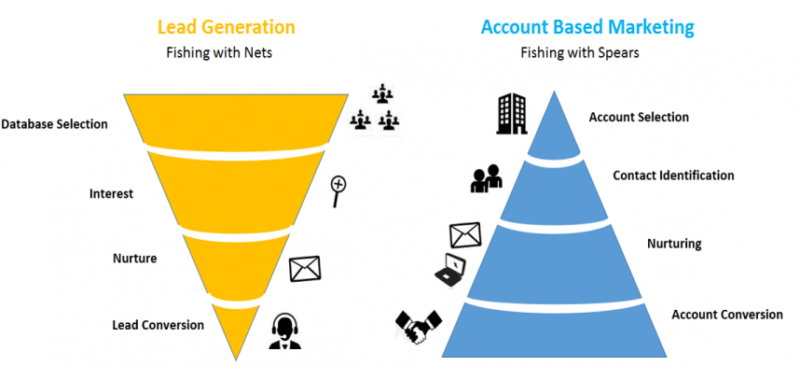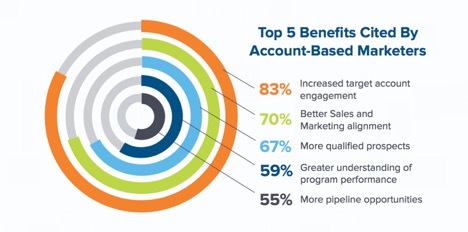Generating high-quality traffic and leads is the number-one challenge for B2B marketers, followed by proving the ROI of marketing activities and securing enough budget, according to a study by HubSpot. Account-based marketing (ABM), is one solution to these problems that many B2B marketers are implementing.
While account-based marketing is not hot-off-the-press new, many B2B marketers still have not tested out the ABM waters yet. Here’s a cheat sheet explaining the what, who, where, when, why, and how of ABM.
What Is ABM?
In a nutshell, Demandbase says, “ABM helps B2B marketers identify and target the accounts they value the most. ABM solutions typically include account-based data and technology to help companies identify, attract, engage, convert, close and then measure progress against customers and prospects.” It’s a strategic process that focuses on a highly specific target account list.
ABM aligns the sales and marketing teams and utilizes AI to identify who visits your website and if they are a potentially serious prospect. Personalization is an element that plays into the ABM strategy as well. Here are the differences between the traditional marketing approach with lead generation and the ABM approach:
Who Does ABM Impact?
ABM impacts B2B marketing, sales, finance, and operations. Marketing and sales teams must be closely aligned and open-minded to changing their methodologies for reaching their audiences. The finance team will need to reallocate the budget a bit, and the operations team will need to coordinate with the marketing and sales teams.
ABM brings benefits to each of these teams:
- Marketers: campaigns that are more targeted, efficient, and correlated to revenue
- Sales: greater accuracy, coordination with marketing, and velocity in target accounts
- Finance: greater predictability, transparency, and visibility into marketing expense ROI
- Operations: structured platforms between sales and marketing
Where Does ABM Live?
Most ABM strategy happens online. A necessary investment in robust ABM software is essential to correctly implement techniques. The software collects data in the background, such as web visits from target accounts, and uses algorithms to identify serious prospects. You can tie in software for analytics, account selection, engagement, sales enablement, and measurement that improve your ABM strategy. There are endless ways to reach your target account list.
When to Implement ABM?
It might be time for account-based marketing if your B2B company is reaching out to the masses in a vertical, but not closing enough deals. Even if you are having success, getting more specific and personalized with your marketing can increase your ROI and help you win those dream accounts.
ABM may sound intimidating, but it doesn’t have to be. You can take a risk-reduced, phased approach to implement an ABM strategy.
Why Implement ABM?
According to ITSMA, almost 85% of marketers who measure ROI describe account-based marketing as delivering higher returns than any other marketing approach, with half of those marketers citing significantly higher returns.
ABM solves many problems B2B marketers have, such as wasting time on prospects who are not interested in your product or service. It makes your marketing budget go further and demands marketing and sales teams work together. Other than the time and cost of the initial ABM strategy setup, there are not many drawbacks.
How Does It Work?
First, the executives of the sales, marketing, operations, and finance teams need to align with changing the sales and marketing processes. If this isn’t possible, get together a group of people who want to prove the concept, and once proven, executives can get on board.
Next, marketing will decide on the characteristics of the ideal target accounts and identify companies that fit the criteria. Marketing to companies that are your optimal focus saves money and increases the likelihood of making it all the way through the sales funnel. The sales team can add to or edit this list as necessary until both groups are confident they have a list of ideal target accounts. This list should always be evolving.
Once you have your target account list, you are ready to form a strategy and engage.
Lastly, measure the account data. Rather than looking at traditional marketing metrics, look at the data from individual accounts. Figure out what went well and what didn’t. Continue the strategies that worked, and improve the ones that didn’t work as well.
Should I Use ABM?
Marketing tactics and strategies come and go. Some are here for the long haul, and some are just the shiny new thing. ABM has actually been around for decades. What’s changed is actually naming the program and availability of supporting software technologies stacks.
Contact Our ABM Specialists
ABM can be a bit of a mystery if it’s not your area of expertise. That’s where we come in! We’re a Demandbase certified partner and Bizible partner. Contact us to discuss your account-based marketing strategy.






